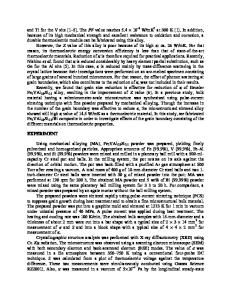Effect of Combined Addition of Silicon Carbide Whiskers and Fullerene Nanoparticles on Properties of Thermoelectric Zinc
- PDF / 146,442 Bytes
- 8 Pages / 612 x 792 pts (letter) Page_size
- 69 Downloads / 356 Views
1044-U06-17
Effect of Combined Addition of Silicon Carbide Whiskers and Fullerene Nanoparticles on Properties of Thermoelectric Zinc Antimonide Takashi Itoh1, Nobuhisa Asari2, Nobuyuki Kanetake2, and Akira Okada3 1 EcoTopia Science Institute, Nagoya University, Furo-Cho, Chikusa-Ku, Nagoya, 464-8603, Japan 2 Materials Science and Engineering, Nagoya University, Furo-Cho, Chikusa-Ku, Nagoya, 4648603, Japan 3 Nissan Research Center, Nissan Motor Co. Ltd., 1 Natsushima-Cho, Yokosuka, 237-8523, Japan ABSTRACT Thermoelectric power generation is a hopeful method harnessing waste thermal energy particularly covering a middle temperature range between 500 and 800 K. A Zn4Sb3 compound is a promising "phonon glass electron crystal" material applicable to thermoelectric power generation around 700 K. This material, however, has a problem of its brittleness. In this research, the silicon carbide whiskers were added into the Zn4Sb3 compound for overcoming the brittleness, and the fullerene nanoparticles were also added for improving the thermoelectric performance. The Zn4Sb3 compound was synthesized from mixture of pure zinc and antimony powders by a liquid-solid phase reactions method. Firstly, the synthesized compound powder was mixed with the fullerene nanoparticles. The planetary ball milling method was used in order to disentangle the fullerene agglomerate and to obtain a uniform mixture. Subsequently, the mixture was uniformly mixed with the SiC whiskers by the planetary ball milling. The final mixture was consolidated by the pulse discharge sintering. The synthesized phases were identified by XRD. The morphology of the whiskers after mixing was observed. The flexural strength and the thermoelectric properties of the sintered samples were measured. The length of SiC whiskers and the flexural strength were decreased with the mixing time. Though the addition of SiC whiskers lowered the thermoelectric performance, the combined addition of SiC whiskers and fullerene nanoparticles restored the performance especially through a decrease of the thermal conductivity owing to the phonon scattering. INTRODUCTION From thirty to seventy percentage of the primary or chemical energy originating from fossil fuels such as petroleum, natural gas, and coal in most current energy systems is not used and is wasted during the energy conversion. To generate electricity from such waste-heat resources will increase in importance more and more from a standpoint of saving energy. Thermoelectric devices that can directly convert the heat energy into electrical energy are promising to generate electricity from various heat resources such as automobiles, cogeneration systems, and waste material incinerators. The exhaust heat from various energy systems has a middle temperature range between 500 and 800 K. Developing high-performance thermoelectric materials applicable in this middle temperature range is thus indispensable to realize the thermoelectric power generation systems for routine use. A Zn4Sb3 compound is a promising "phonon glass electron cry
Data Loading...




